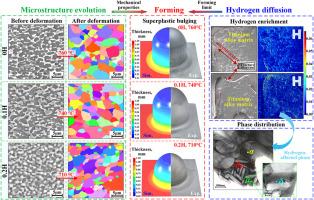氢化Ti-4.5Al-3V-2Mo-2Fe合金的超塑性变形行为及组织演化机制
IF 8.3
2区 工程技术
Q1 CHEMISTRY, PHYSICAL
引用次数: 0
摘要
研究了不同氢含量的Ti-4.5Al-3V-2Mo-2Fe (SP700)合金的超塑性变形行为和显微组织演变。单轴拉伸试验表明,与原始材料相比,0.1 wt% H的SP700合金可使最佳超塑性成形温度降低20℃,而伸长率仅降低17%。氢的加入促进了动态再结晶(DRX),缓解了应力集中,并显著抑制了晶粒的过度生长,使断口处的晶粒尺寸从5.1 μm减小到4.2 μm。然而,较高的氢含量(0.2 wt%)会导致局部氢富集,导致β相硬化和伸长率大幅下降。氢显著降低了β-相变温度,随着氢含量的增加,最佳超塑温度随相变温度同步降低。在超塑性变形过程中,氢通过位错网络迅速扩散,在高应变区积累,促进初生α相(αp)以棒状形态析出。与单轴拉伸相比,超塑性胀形中的多轴应力状态促进了氢的均匀扩散,延缓了局部氢的富集,保持了稳定的超塑性。在较低的最佳超塑温度(低20℃)下,0.1 wt% H合金的成形极限与原始材料相当,而0.2 wt% H合金的塑性明显不如原始材料。本文章由计算机程序翻译,如有差异,请以英文原文为准。

Superplastic deformation behavior and microstructure evolution mechanism of hydrogenated Ti-4.5Al–3V–2Mo–2Fe alloy
This research investigates the superplastic deformation behavior and microstructure evolution of Ti-4.5Al–3V–2Mo–2Fe (SP700) alloys with varying hydrogen contents. Uniaxial tensile tests reveal that 0.1 wt% H SP700 alloy reduces the optimal superplastic forming (SPF) temperature by 20 °C, while only decreasing the elongation by 17 % compared to the original material. The incorporation of hydrogen promotes dynamic recrystallization (DRX), alleviates stress concentration, and significantly inhibits excessive grain growth, reducing the grain size at the fracture from 5.1 μm to 4.2 μm. However, a higher hydrogen content (0.2 wt%) leads to localized hydrogen enrichment, resulting in β-phase hardening and a substantial decline in elongation. Hydrogen notably lowers the β-transus temperature, with the increase of hydrogen content, the optimum superplastic temperature decreases synchronously with the phase transition temperature. During superplastic deformation, hydrogen rapidly diffuses through dislocation networks, accumulates in high strain regions, and facilitates the precipitation of primary α phase (αp) in a rod-like morphology. Compared to uniaxial tension, the multiaxial stress state in superplastic bulging promotes uniform hydrogen diffusion, delays localized hydrogen enrichment, and maintains stable superplasticity. At the reduced optimal superplastic temperature (20 °C lower), the 0.1 wt% H alloy demonstrates comparable forming limits to the original material, while the 0.2 wt% H alloy exhibits significantly inferior plasticity.
求助全文
通过发布文献求助,成功后即可免费获取论文全文。
去求助
来源期刊

International Journal of Hydrogen Energy
工程技术-环境科学
CiteScore
13.50
自引率
25.00%
发文量
3502
审稿时长
60 days
期刊介绍:
The objective of the International Journal of Hydrogen Energy is to facilitate the exchange of new ideas, technological advancements, and research findings in the field of Hydrogen Energy among scientists and engineers worldwide. This journal showcases original research, both analytical and experimental, covering various aspects of Hydrogen Energy. These include production, storage, transmission, utilization, enabling technologies, environmental impact, economic considerations, and global perspectives on hydrogen and its carriers such as NH3, CH4, alcohols, etc.
The utilization aspect encompasses various methods such as thermochemical (combustion), photochemical, electrochemical (fuel cells), and nuclear conversion of hydrogen, hydrogen isotopes, and hydrogen carriers into thermal, mechanical, and electrical energies. The applications of these energies can be found in transportation (including aerospace), industrial, commercial, and residential sectors.
 求助内容:
求助内容: 应助结果提醒方式:
应助结果提醒方式:


